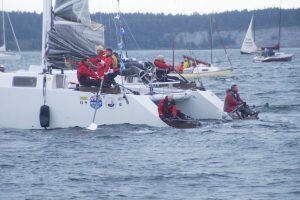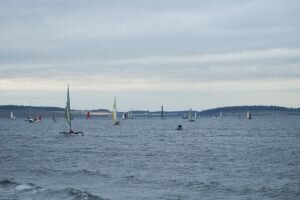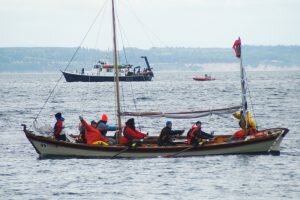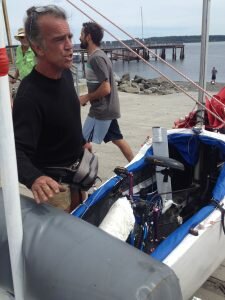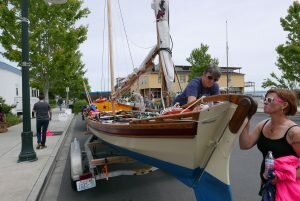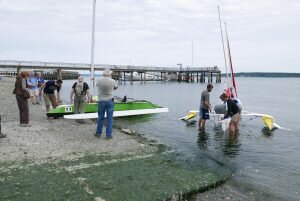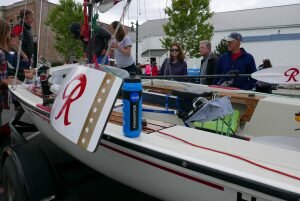 By Oliver Lazenby
By Oliver Lazenby
A self-proclaimed “shop rat” from a Port Townsend boat shop told me the key to quickly making it up the Inside Channel to Alaska without a motor is having the right combination of human power and sailing ability. Common sense suggests a high performance (i.e. expensive) catamaran or trimaran would be the fastest boat for the job. Throw in variables like winds, weather and tides, however, and at some points in the journey paddles could be more efficient than sails.
Competitors in the second annual Race to Alaska, a motor-less unsupported boat race from Port Townsend to Ketchikan, set off at 6 a.m. this morning. Judging from their boats, there’s still no consensus on the right balance.
The boats that set off this morning ranged from sailboats with human power added almost as an afterthought in the form of oars or bicycle pedaled propellers, to kayaks and even a stand-up paddleboard with no ability to harness the wind. Others took middle of the road approaches: team Kraken-Up consists of eight women rowing a dory-style wooden boat with a small sail that team member Kim Carver admitted won’t provide much juice; team Take Me to the Volcano’s solo racer Matt Johnson is racing a lightweight trimaran that’s fast under sail and light enough to make pedaling efficient – he pedaled it to Port Townsend from Seattle two days before the race. Oh yeah, and he’s a professional cyclist.
Human-power vs sail power isn’t the only balance teams had to strike. Speed vs survivability is another important compromise, race director Jake Beattie explains in his description for team Heart of Gold. Heart of Gold is Karl Kruger of Orcas Island, who plans to ride his 19-foot stand-up paddleboard to Ketchikan. By Beattie's judgement, the setup is short on survivability.
As Beattie explains online, “Boat to Alaska? Hard. Engineless? Harder. SUP? Bonkers.” Kruger, a former mountain guide with a penchant for suffering and a fondness for traveling fast and light, was one of the first to round the northern tip of Port Townsend this morning.
Of course, not all teams care about competing. Some just want to see if they can make it. One team finished building its homemade boat less than a week before the race and tried it out in a lake or two in Idaho before showing up in Port Townsend. “If I see a pub along the way, we’re stopping,” said the skipper. He told me his team is named the Hillbilly Rebels, although that name doesn’t appear in the official list of teams.
Fast teams have already pulled in to Victoria Harbour, the finish line for the first leg of the race. The 40-mile trip across the Strait of Juan De Fuca constitutes a test for the racers and their boats. They must finish the leg in 36 hours to qualify for the rest of the journey. Some will drop out with broken boats, bruised spirits or both. The rest of the race, from Victoria to Ketchikan, begins at 12 p.m. on Sunday.
Learn more at R2AK.com or track the racers at tracker.R2AK.com.
